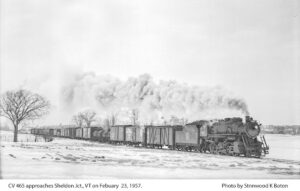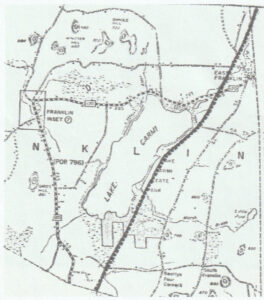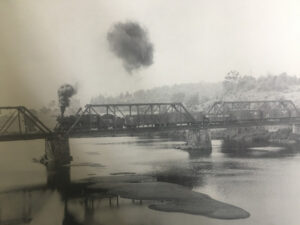Sheldon Junction Railroad Impact

The building of railway greatly impacted any community where trains rolled and commerce prospered. According to Sheldon Town records J W Sheldon awarded the railroad right of way to the Missisquoi Railroad in 1870 beginning an over 100 year impact on Sheldon Junction as the terminus for two and nearly three railroads. With the awarding of contracts by Dwight Eisenhower in the 1960 for the federal interstate highway system, the demise of small rural railroad ventures began. Trains working in conjunction with tucking companies at their larger locations provide interstate transport of any imaginable commodity.
The Missisquoi Railroad, later called the Missisquoi Valley Railroad and eventually the Central Vermont Railroad, was completed with the first train out of Sheldon on July 4, 1871. The Sheldon Jct. depot was constructed in 1889 and was considered a passenger depot. The first employee fatality occurred on the evening of Feb. 5, 1901 when an employee died while attempting to pull a train out of a snow drift.
The Lamoille Valley Railroad also commenced building in 1870 but financial issues postponed the completion into Sheldon until the first engine arrived on July 27, 1877. The LVRR eventually became known as the St. Johnsbury and Lake Champlain Railroad.
Although milk proved to be the most frequently transported commodity, passenger cars ran on both rails especially during the tourist book… Trains did wreck and bridges did burn and collapse throughout the history of the railroad but perhaps the greatest tragedy occurred when a locomotive and car collided. According to the St. Albans Daily Messenger on Sept. 30, 1963 “The worst single crash came at Sheldon Jct., VT where four men on a hunting trip were fatally injured when their car collided with a St. Johnsbury and Lamoille County freight at a graded crossing. Although graded crossing continue to exist on rural secondary roads the state mandated the “Stop, Look, and Listen” policy with lights, gates, and bells at most crossings.
On April 25, 1881 a charter was granted calling for a railroad to begin in East Franklin at the Canadian border and to join the St. Johnsbury and Missisquoi railroads at Sheldon Jct.

The map to the left shows the rail bed along Lake Carmi. From 1881 until 1961 various news reports demonstrated an interest in completion of the road bed and the railway with little success.
The Swanton Courier reported on June 17 1882, “large large gangs of men are at work pushing the road to Sheldon Junction, to which place it will be completed this season”
The Swanton Courier reported on August 5, 1882 “After much speculation and hope, the Montreal & Sheldon Junction railroad has broken ground at this point.”
The St. Johnsbury Index reported on March 16, 1883 “Work on the Canada Junction branch of the Southwestern from the Canada line to Sheldon is going forward. The grading is completed to within two miles of Sheldon Junction. The road will be opened for traffic about Jun 1
And then the St. Johnsbury Index reported on August 16, 1882 “It is also stated that work has been suspended on the branch of the Montreal, Portland and Boston road between Sheldon Junction and the Canada line, and that writs of attachment have been issued against the road and the construction property.”
New articles of the day covered the struggle for ownership of the line. Had the project been completed a secondary point of access into Canada and into Montreal would have opened. Needless to say the proprietors of competing railroad resisted and the turmoil resulted in the railroad never being built. In 1900 the CVRR attempted to secure the right to construct a line from Franham to Frelighsburg, Que which they through could be joined to the existing CVRR line in Sheldon Jct. VT. Rumors ran amuck and between investors and government agencies on both sides of the border the matter seemed to be laid to rest. However The Montpelier Monitor reported on Dec 14, 1961 “It is rumored that the Boston and Lowell railroad is negotiating for the possession of the road from Sheldon Jct. to East Franklin.” Noting appears to have come from that negotiation.
And so the railroad impacted the development and prosperity of Sheldon Jct. making it a terminus for many purposes. The agriculture business of the area could obtain feed and fertilizer, the production of raw milk and its delivery to markets as far away as Boston resulted in a variety of creameries being built. Sheldon Jct. was the hub of the transport of “mineral waters” from nearby springs including a regular shipment to then President Grant. Passenger cars provide transport for tourist to the springs and to the area in general leading to a tourist hub with several hotels and motels in the area.

Undoubtedly the railroad provided a major impact on the Franklin Country Mechanical and Agricultural Society’s decision to purchase land in the junction for the “Sheldon Fair. Additional sidings provided for passenger cars to remain at the fair for the day. Commodities needed were transported by rail. Local hotels, notably the Riverside, prospered due to meetings and accommodations.
More aspects of this lively and prosperous Sheldon Jct. will be covered in our next round of writing. The now quiet intersection of two state highways no longer boasts of hotels, stores, garages, dance halls, fairs and the like but in spite of its current laid back state it once was a lively, active, and socially sought after community .